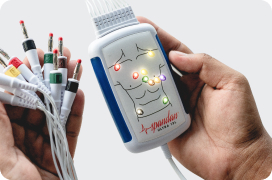
Author:- Mr. Ritesh Sharma
Have you ever wondered what prevents the backflow of blood in heart? The human heart is 250-350 grams miracle pumping blood to every part of our being tirelessly 24*7. This organ pumps blood to all the vital organs of the body and ensures that they receive adequate amounts of oxygen and nutrients. However, the magic of our ticker would be diminished if there was nothing to prevent the backflow of blood. So, the question arises, What prevents the backflow of blood in heart, the answer to this question is rather intricate.
This blog will delve into what prevents the backflow of blood in heart and uncover some worthy insights into our cardiovascular system. We will discuss how the mechanics of the cardiovascular system work to ensure that there is no backflow of blood in the heart.
The Anatomy of the Heart
Before delving into what prevents the blood flow in heart, let’s discuss the heart’s anatomy to learn the mechanics of the cardiovascular system in a more refined manner. The human heart is a muscular organ that contains four distinct chambers: the left and right atria, and the left and right ventricles. All these chambers work together in harmony to ensure the blood circulation symphony throughout the body. If any of these four chambers dysfunctions, the blood doesn’t reach the vital organs of the body.
What prevents the backflow of blood in heart?
The prevention of backflow of blood in the heart is mostly done by valves. The valves are especially structured to as like gates that regulate the blood flow between the four chambers of the heart. There are four main valves found in the human heart- the tricuspid valve, the pulmonary valve, the mitral valve, and the aortic valve. Let’s discuss these valves in a more elaborate manner below:-
- Tricuspid Valve: This valve is situated between the right atrium and the right ventricle. This valve consists of three flaps or cusps. These cusps open and close so that the blood flow from the atrium to the ventricle can be properly facilitated. This way the valve prevents the backflow of blood in heart.
- Pulmonary Valve: This valve is positioned between the right ventricle and the pulmonary artery. Through this valve, the blood is propelled from the heart to the lungs for oxygenation. It opens automatically to let blood to go the lungs for oxygenation and afterward closes to prevent the backflow to the ventricle.
- Mitral Valve: Mitral Valve is also known as bicuspid valve and it is positioned between the left atrium and the left ventricle. It consists of two cusps and functions similarly to the tricuspid valve. It permits blood to flow from the atrium to the ventricle while preventing backflow.
- Aortic Valve: This valve is positioned between the left ventricle and the aorta (the largest artery in the circulatory system). Through this valve, the oxygenated blood from the heart to the vital organs of the body is pumped. Much like other valves, it opens automatically to let the blood transfer from the heart to different parts of the body and prevents the backflow to blood in the heart.
Mechanism of Valve Function
To find out what prevents the backflow of blood in heart, it is essential to learn the mechanism of valve function. Pressure differentials and structural integrity form the sophisticated mechanism of valve function. This mechanism goes like this:-
When the heart contracts (systole), the pressure within the chambers significantly increases causing the valves to open to allow the blood to flow in the relevant direction. Similarly, when the heart relaxes (diastole), the pressure within the chambers significantly decreases causing the valves to close so that the backflow of blood in the heart can be prevented.
The structural integrity of the valves is also vital for its vital functioning. The valves inside the heart are composed of strong fibrous tissues, including collagen and elastin, which enable them to withstand the forces exerted by blood flow and maintain their shape.
Disorders Affecting Valve Function
Most of the time, the valves are super effective and steer clear of all disorders with their strengths. However, they are not prone to all sorts of disorders. The following is a list of the disorders that can affect the valve function:-
- Stenosis: In this condition, the valves inside the heart are narrowed. Due to this, the blood flow in the affected chamber gets restricted. Stenosis can lead to implications that disrupt the opening and closing of the valves. This results in decreased cardiac output and other potential complications.
- Regurgitation (Insufficiency): Regurgitation is a disorder in which the valve is unable to close completely. This leads to the leak of blood backward in the preceding chamber. This backflow of blood can put a strain on the heart leading to complications such as fatigue, shortness of breath, and heart palpitations.
- Prolapse: Valve prolapse is a rare case that occurs when the flaps of the valve bulge backward into the preceding chamber. This normally occurs during the contraction of the heart. The most common valve prolapse is mitral valve prolapse, but other valves can be affected as well. While valve prolapse is normally not a cause for alarm in most cases, sometimes it requires medical intervention.
Prevention and Treatment
Preventing disorders related to heart valves requires a steadfast approach. You must revamp your lifestyle with some modifications, such as regular exercise, a balanced diet, and avoidance of smoking. Apart from this, you must also treat any kinds of underlying medical conditions, such as coronary artery diseases, cardiac arrhythmias of different arrhythmia classifications, etc.
Moreover, if you are affected by valve disorders, you can adopt treatment depending on the severity of the condition. In mild cases, close monitoring and lifestyle changes are adequate to control the situation. However, in severe cases, you might require medications and surgical intervention to treat the disorder, for example, valve repair or replacement.
In conclusion, the question of what prevents the backflow of blood in heart has a definitive answer. It is because of the valves and their supreme mechanism. These valves ensure that parts of the body receive an adequate amount of blood to get the required oxygen and nutrients. Even if these valves get disordered, they can be treated with lifestyle modifications, regular check-ups, and in severe cases through medications and surgical procedures.




